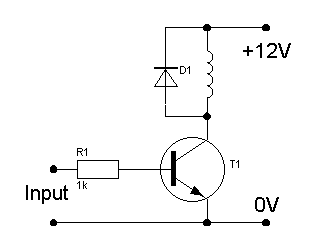Eng.Hassan
Newbie level 4
Hello every one,
I have bought a solenoid valve that requires 24Vdc with 750mA and I was trying to use the 2N222A transistor to drive it though a Xbee which give 3.3Vdc but just seconds after the connection it get very hot ( I mean the BJT ) I looked at the Datasheet and it states that the max collector current is 1Amp ?!! I don't know how to resolve this issue and I'm not quite sure if the MOSFET will solve this heat sink problem?
Any suggestion or recommendation?
Thanks & Regards,
P.S.
1) I'm using a 24Vdc 2.8Amp power supply to supply the solenoid valve
2) I'm using the normal connection shown in the diagram but with 24Vdc

I have bought a solenoid valve that requires 24Vdc with 750mA and I was trying to use the 2N222A transistor to drive it though a Xbee which give 3.3Vdc but just seconds after the connection it get very hot ( I mean the BJT ) I looked at the Datasheet and it states that the max collector current is 1Amp ?!! I don't know how to resolve this issue and I'm not quite sure if the MOSFET will solve this heat sink problem?
Any suggestion or recommendation?
Thanks & Regards,
P.S.
1) I'm using a 24Vdc 2.8Amp power supply to supply the solenoid valve
2) I'm using the normal connection shown in the diagram but with 24Vdc
